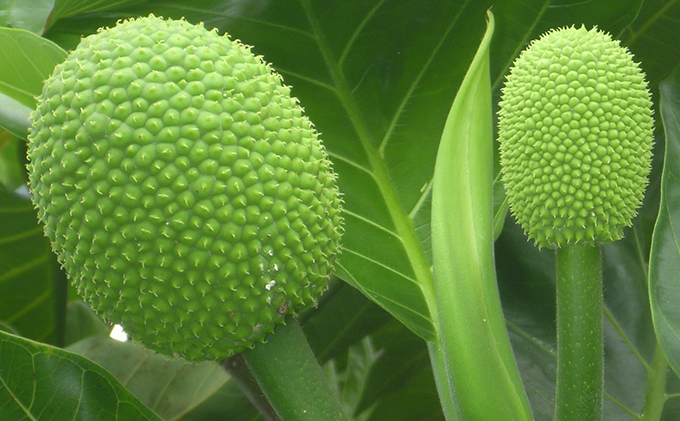By learning when to best select your fruit, you’ll be rewarded with better tasting food. Though breadfruit can be eaten at all stages of its life, some stages are better used for different recipes than others. Knowing when to pick your fruit is the first step to bringing it from the tree to your kitchen table.
Selecting
The stages of a breadfruit are commonly referred to as immature, mature or ripe.
An immature breadfruit is of course smaller. It is bright green in color with white-green flesh 1 to 5 mm beneath the skin, and will bleed a sticky, whitish sap when cut or bruised. It can be boiled, pickled or marinated, and has a taste similar to artichoke hearts. It can be sliced—seeds and all—and cooked as a vegetable.
Mature breadfruit is starchy and firm. Depending on the variety, the skin will change from the bright green of an immature fruit to darker green, golden yellow, and even a rusty orange color. The flesh will be firm, with color from white to pale, creamy yellow. A few splotches of dried sap dot the skin, with slight brown cracking or crusting around individual sections. In the mature stage, breadfruit is the perfect substitute for any starchy root vegetable, and can be made into dishes as complex as curry and jambalaya, or as simple as French Fries. It is delicious roasted over an open flame, or prepared in the finest of restaurant kitchens.
Ripe fruit are soft to the touch, with an aromatic smell. The creamy, sweet flesh can be made into beverages, pies, cakes, and other desserts, and is great food for babies. The peel is yellow-green to yellow-brown in color. This is the only stage where the fruit can be eaten raw, and the taste and texture is similar to custard.

Harvest
Careful harvesting is essential for maintaining fruit quality. Breadfruit trees produce average yields of 100-200 fruit, each weighing 300 g to 6 kg (3/4 lb to 13 lb) depending on the variety. Fruit that fall to the ground will be bruised and soften sooner than those that are gently handled. For fruit within easy reach, simply cut or twist the stem to snap it from the branch; turn the fruit upside down to let the sap bleed from the end of the stem. Higher fruit are harvested with a sharp scythe or curved knife attached to the end of a long, sturdy pole. The fruit will fall to the ground unless a second person catches them–a challenging and risky task. A basket or net attached to the end of the pole makes harvesting easier and safer. We found that using a telescopic pruner with a net zip-tied to the pole works very well. Picking poles can also be made by attaching a small branch to the end, forming a fork that grasps the stem of the fruit. In the Pacific Islands, poles are often made from the light-weight stems of the abundant Hibiscus tiliaceus plant.
Post Harvest
Breadfruit quickly ripens 1 to 3 days after harvest. Post harvest handling and storage methods can extend the shelf life of fresh fruit for up to 25 days by careful harvesting and by pre-cooling fruit with chipped ice in the field and during transport. Covering fruit with water can also delay ripening for a 1-2 days. Research on extending shelf life has been carried out in the Caribbean region, especially at the University of the West Indies, and in Samoa, Fiji, and Hawaii. Packaging fruit in sealed, polyethylene bags or plastic wrap can improve shelf life and fruit quality for 5-7 days. Refrigeration increases shelf life, but too cool temperatures can reduce fruit quality and appearance by causing browning of the skin and fruit shrinkage. Browning of the skin is a cosmetic problem, but the fruit is still quite suitable for cooking and processing. The optimum storage temperature is 12-16°C for 7-10 days.
If the fruit is packaged in polyethylene bags or dipped in wax, it can be stored for up to two weeks. Controlled atmosphere (CA) storage of fruit in 5% oxygen and 5% carbon dioxide at 16°C can considerably extend shelf life and quality, with a shelf life of 3-4 weeks. Learn more about harvesting and handling fruit in our Breadfruit Production Guide. Minimal processing of the fruit, by blanching then freezing slices or wedges, is an excellent method to extend shelf life and storage. Because the fruit is perishable, availability of fresh fruit is mainly limited to tropical regions where it is grown. However, fresh breadfruit and a range of breadfruit products are becoming available.
.svg)

